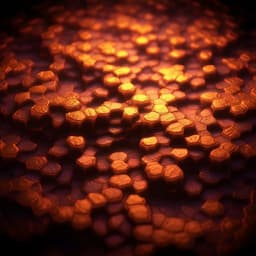
Physics
Current-induced domain wall motion in a van der Waals ferromagnet Fe3GeTe2
W. Zhang, T. Ma, et al.
This groundbreaking research by Wenjie Zhang and colleagues reveals a significant advancement in domain wall motion within Fe3GeTe2 flakes, showcasing a velocity an order of magnitude greater than previous studies. The fascinating interplay between spin transfer and spin-orbit torques in heterostructures paves the way for innovative applications in materials science.
~3 min • Beginner • English
Introduction
Spin currents, carrying spin (and possibly orbital) angular momentum, can exert torques on local magnetizations, enabling magnetization manipulation fundamental to spintronic devices such as racetrack memories that rely on current-induced domain wall motion (CIDWM) via spin-transfer torque (STT) and/or spin-orbit torque (SOT). Two-dimensional van der Waals magnets, notably metallic Fe3GeTe2 (FGT), offer strong perpendicular magnetic anisotropy and tunable Curie temperature, and exhibit chiral spin textures (skyrmions and spirals) that imply a Dzyaloshinskii–Moriya interaction (DMI). Given that such textures appear in relatively thick flakes, interfacial DMI is unlikely; instead, broken bulk inversion symmetry—due to unequal occupation of Fe Wyckoff sites and Fe defects—supports a bulk DMI. Prior current-induced manipulation studies in FGT mostly relied on anomalous Hall measurements or LTEM on thick lamellae and showed low DW velocities. Kerr microscopy, with high spatial resolution and strong magneto-optical contrast in thin FGT, enables direct imaging of CIDWM. This study investigates CIDWM in pristine FGT and in FGT/Pt and FGT/W heterostructures to clarify the roles and competition of STT and SOT, the effect of Joule heating and Curie temperature, and signatures of bulk DMI in domain wall dynamics.
Literature Review
Earlier works established racetrack memory concepts and STT/SOT mechanisms in conventional metallic systems and demonstrated high DW velocities in engineered stacks. In van der Waals FGT, chiral textures (skyrmion bubbles, spin spirals) were reported, with bulk inversion symmetry breaking and defect-induced DMI identified as their origin, as opposed to interfacial oxidation-driven DMI. Current-induced switching and torque effects in FGT have been explored primarily via transport (anomalous Hall), with LTEM providing direct but thickness-limited imaging; those studies reported low DW velocities. Kerr microscopy has been validated as a sensitive probe of magnetization in FGT nanoflakes. Reports also suggested possible intrinsic bulk SOTs in FGT, though their origin and impact on DW dynamics remained unclear, motivating the present direct imaging and comparative heterostructure approach.
Methodology
- Materials and device fabrication: FGT nanoflakes were exfoliated from single crystals onto Si/SiO2 (285 nm) substrates in a nitrogen glovebox. PMMA (950K A5) was spin-coated as a protective resist. Racetrack devices (length ~15 μm, width 2–4 μm) were patterned by e-beam lithography. Ti(4 nm)/Au(40 nm) contacts were deposited by magnetron sputtering. Etching of excess material was done using Ar ion milling and focused ion beam (Ga-FIB).
- Heavy metal heterostructures: After exfoliation, selected FGT flakes were transferred without air exposure via UHV load-lock to a sputter system. A 3 nm Pt or 3 nm W overlayer was deposited to form HM/FGT bilayers with clean interfaces. Devices exposed to air prior to deposition served as controls for interface transparency.
- Kerr microscopy and environment: Devices were cooled in a CryoVac cryostat using liquid He or N2. Polar Kerr microscopy imaged out-of-plane magnetization with a Nikon 60X (NA 0.7) objective. Longitudinal in-plane fields Hx were applied as needed (typically ±300 Oe for SOT switching tests).
- Current pulsing and DW tracking: For pristine FGT, CIDWM was excited by current pulses of width τ = 5–80 ns (typical 5–10 ns), at T = 20–140 K. Sequences of Kerr images were acquired with one or more pulses between frames. Domain wall positions were extracted per frame and plotted versus accumulated pulse duration t; the DW velocity v was determined from linear fits of position versus t. Threshold behaviors were evaluated by sweeping current density J upward at fixed T and τ until DW erasure (device heated beyond Tc) to identify vmax at that condition.
- Parameter sweeps: v(J) was measured at various τ and T. Heating effects were analyzed with a net heating power model: (JA)^2 R − ρ τ^−1 (A: device cross-sectional area; R: device resistance; ρ: effective heat dissipation to substrate and top side). Scaling of vmax with τ and J was obtained by fitting v(J) curves.
- SOT switching tests: In FGT/Pt and FGT/W, current along x through the HM generated spin Hall spin currents incident on FGT, producing SOT. Under Hx = 300 Oe, differential Kerr images (frame-to-frame subtraction) captured magnetization switching; reversal of current or field confirmed SOT polarity. The opposite spin Hall angles of Pt and W were used to distinguish SOT sign.
- CIDWM in HM/FGT: DW motion under pulses was imaged similarly. Direction and speed were recorded versus current magnitude and sign. Field dependence v(Hx) was measured and compared between FGT/W and pristine FGT. A 1D domain-wall model including both STT and SOT and an effective DMI field was used to fit v(Hx) for up/down and down/up DWs; fit parameters (e.g., DMI field) are reported in the Supplementary Information.
- Representative conditions and metrics: Example: pristine FGT, thickness 10.5 nm, T = 20 K, J = 2.41×10^11 A m^−2, τ = 5–10 ns. For heterostructures, typical tests at T = 70–80 K, τ = 2–10 ns, J ≈ (9–10)×10^10 A m^−2, Hx = ±300 Oe.
Key Findings
- Direct imaging of STT-driven CIDWM in pristine FGT: DWs move opposite to electron flow (opposite to current direction), consistent with majority-spin-polarized conduction electrons.
- Velocity and thresholds at low temperature: For a 10.5 nm FGT flake at T = 20 K and J = 2.41×10^11 A m^−2, v = 5.68 m s^−1. Lower threshold current density for motion: ≈1.8×10^11 A m^−2; upper threshold (DW erasure due to heating above Tc ≈150 K): ≈2.5×10^11 A m^−2. Maximum observed DW speed vmax = 5.68 m s^−1, about an order of magnitude higher than prior FGT reports.
- Joule heating-limited performance: vmax increases for shorter pulses and lower base temperatures. At T = 20 K, vmax scales as vmax ∝ τ^−0.20 (J − K)^0.36 (empirical fit). The net heating model ( (JA)^2 R − ρ τ^−1 ) explains that shorter τ requires higher J to reach Tc transiently, enabling higher instantaneous v before erasure. v(T) for τ = 5 ns decreases monotonically from 20 K to 140 K and vanishes near Tc ≈ 150 K.
- SOT switching in HM/FGT: Under Hx = 300 Oe, current pulses switch FGT magnetization via SOT. Polarity reverses between Pt and W, consistent with their opposite spin Hall angles. Clean interfaces (no air exposure) are essential for full switching.
- CIDWM in FGT/Pt shows torque competition: DW direction depends on current magnitude. At higher J (e.g., j ≈ 9.6×10^10 A m^−2, τ = 2 ns, T = 70 K), DWs move parallel to current (SOT-dominated); at slightly lower J (≈9.4×10^10 A m^−2) they move antiparallel (STT-dominated). Speeds are ~0.2–0.3 m s^−1 in both regimes, about 10× slower than in pristine FGT.
- CIDWM in FGT/W aligns with pristine behavior: DWs move antiparallel to current across J, indicating STT and SOT act in the same direction due to W’s negative spin Hall angle. Speeds are comparable to pristine FGT under similar conditions.
- Longitudinal field dependence and DMI: In pristine FGT, v(Hx) exhibits dome-shaped behavior with peaks offset from zero field by ~+70 Oe (up/down DW) and −70 Oe (down/up DW), indicating Néel DWs stabilized by bulk DMI. In FGT/W, the offset and asymmetry are larger due to added SOT; fits to a 1D DW model confirm STT dominance and yield an effective DMI field of about −70 Oe in pristine FGT.
- Mechanistic insights: In FGT/Pt, with increasing J, Joule heating reduces M and the STT contribution vSTT, while vSOT remains nearly constant, leading to a reversal of net DW motion direction. In FGT/W, vSOT and vSTT are both antiparallel to current, so no reversal occurs.
Discussion
The study addresses how spin torques drive domain walls in a 2D metallic van der Waals ferromagnet and how bulk DMI influences DW structure and dynamics. Direct Kerr imaging clarifies that pristine FGT supports STT-driven DW motion with Néel character arising from bulk DMI linked to Fe-site disorder, evidenced by the offset of v(Hx) peaks for opposite DW polarities. The achievable DW speeds are substantially lower than in conventional racetrack materials, primarily because FGT’s relatively low Curie temperature constrains the maximum usable J before Joule heating erases DWs. Additionally, strong spin–orbit coupling from Te likely reduces current spin polarization and contributes to high Gilbert damping, further lowering STT efficiency.
In HM/FGT bilayers, SOT enables magnetization switching and coexists with STT in DW motion. The FGT/Pt system reveals a clear competition between STT and SOT: as J increases, Joule heating weakens STT while SOT is maintained, causing a direction reversal of DW motion. In FGT/W, STT and SOT cooperate due to the opposite sign of W’s spin Hall angle, preserving the pristine-like antiparallel motion relative to current. Field-dependent velocity trends in FGT/W versus pristine FGT, captured by a 1D DW model including both torques and DMI, confirm the presence and sign of SOT as well as the dominance of STT under these conditions. These insights are relevant for optimizing 2D-magnet-based racetrack devices, where engineering Tc, thermal management, and interface quality can critically impact performance.
Conclusion
Current-induced domain wall motion in Fe3GeTe2 was imaged and quantified. Pristine FGT exhibits STT-driven motion with a maximum DW velocity of 5.68 m s^−1 at 20 K, limited by Joule heating near Tc. The field dependence indicates Néel-type DWs stabilized by bulk DMI originating from Fe defects. In FGT/Pt and FGT/W heterostructures, SOT enables switching and modifies DW dynamics: in FGT/Pt, STT–SOT competition reduces speeds and induces direction reversal with increasing current; in FGT/W, STT and SOT reinforce each other, yielding motion similar to pristine FGT. Clean HM/FGT interfaces are essential to transmit spin currents. Future work should focus on increasing Curie temperature (e.g., alternative 2D ferromagnets with higher Tc), improving thermal management to mitigate Joule heating, optimizing materials to enhance spin polarization and reduce damping, and systematic modeling of STT/SOT balance to achieve higher DW velocities in 2D-magnet racetrack devices.
Limitations
- Thermal limitation: Low Curie temperature of FGT (~150 K) imposes a strict upper bound on current density; Joule heating quickly erases DWs, capping DW velocities. Even at low base temperatures, reduced specific heat allows rapid self-heating, leading to velocity saturation.
- Spin polarization and damping: Strong spin–orbit coupling in Te-containing FGT likely reduces current spin polarization and contributes to high Gilbert damping (~0.6), lowering STT efficiency compared to conventional ferromagnets.
- Interface sensitivity: Effective SOT and full switching require pristine HM/FGT interfaces; air exposure before HM deposition degrades transparency and performance.
- Generalizability: Results are obtained on exfoliated flakes at cryogenic temperatures with specific device geometries and pulse conditions; performance at room temperature or in different device architectures may differ.
- Modeling parameters: The 1D DW model fits (including effective DMI fields and torque efficiencies) depend on sample-specific parameters provided in Supplementary Information; variations across flakes (thickness, defect levels) may affect extracted values.
Related Publications
Explore these studies to deepen your understanding of the subject.







